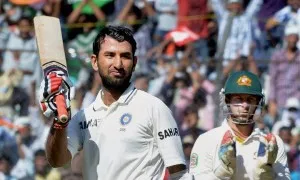Sachin Tendulkar's shadow over the South Africa tour
We sent a team to South Africa two days before an ODI series, to face the world's toughest pace bowling attack, and sniggered when they cut a sorry figure. Even the two-day gaps between games were washed out, which meant zero acclimatisation for our cricket team. But we mocked them for their failure to adjust to bouncy tracks after playing on Indian pitches for so long.
And now, after a two-day practice game, we will be going up against the No.1 Test side on Wednesday (December 18) in Johannesburg, which has South Africa's bounciest, fastest pitch. What's more, there will be two batsmen in the middle order with little experience of Test cricket. Did it have to be this way? Didn't this emerging Indian team deserve a better chance to succeed?

The home runOver the past two years, India played four home series. This presented an ideal opportunity to make the transition to a new batting lineup, replacing the old guard. And to some extent, it did happen.
After our 4-0 drubbing in Australia in 2011-12, Rahul Dravid saw the writing on the wall and called it quits without further ado. He wasn't tempted to play a season of juicy home Tests and sign off on a high note. It was time for the next generation of Indian cricketers to take over, he said at a press conference to announce his retirement in March, 2012: "We are all disappointed by the fact that we didn't do well in England and Australia, not just for the cricketers, but for people all around. Having said that, I feel Indian cricket is in a good place and I think there are some really exciting young talents coming through."
One man who will be grateful to Dravid for exiting when he did is Cheteshwar Pujara. After being in and out of the side for two years, he had a steady position at long last, which he celebrated with a knock of 159 against New Zealand last year in the very first match he played in the slot vacated by Dravid. In 15 Tests so far, he has averaged 65.5, which is second only to Don Bradman in the all-time list of highest Test batting averages.
For years, India's ex-cricketers had lamented the lack of batting talent to replace the ageing superstars. The truth was there was no dearth of talent, only an unwillingness to make the change - even after India's Test performance plummeted in 2011. Sachin Tendulkar's average of 26 in 12 home Tests after the Australia series, in stark contrast to Pujara's average of 80 in the same period, indicates how big a price the team paid because of Tendulkar carrying on to a grand farewell, instead of quitting when Dravid did.
Tendulkar's exit at that point - perhaps after he had finally nailed his coveted 100th ton in an ODI against Bangladesh in March 2012 - would have been ideal for developing another new batting star. Virat Kohli, the only Indian batsman to make a century on the Australia tour, was perfectly placed to step up to Tendulkar's No.4 slot, and become the fulcrum of the new Indian batting order. That would have given the selectors and captain MS Dhoni more latitude in trying out new talent at numbers five and six, and by now India would have had a settled lineup. If Rohit Sharma had got in a season earlier, he too might have crossed 1000 Test runs by now, like Pujara, and been better prepared for the tough South Africa tour.
A proven talent like Ajinkya Rahane, who became one among only 11 players in the history of Ranji cricket to cross 1000 runs in a single season way back in 2008-09, awaits a second chance after playing in one Test match, failing and being discarded. That's another player who might have got more opportunities by now.
Takeaways for startups
There’s a lot to learn from the manner in which the emergence of a new Indian cricket team has been managed. Succession planning is vital, whether you are a startup or a cricket team. An entrepreneur may decide to move on, or an old stalwart may finally hang up his boots. Either way, unless a transition plan is in place, the enterprise can go into a tailspin and valuable time and resources lost. What is the economic cost of an entrepreneur suddenly leaving the company she started? What is the pain a cricket team and its fans feel when it underperforms because of a mismanaged transition?
The Rohit Sharma example shows both the good and the bad of succession planning or its lack in the Indian cricket team. For a player of his class to be taking his place in the eleven shows the bench strength we now have. This is thanks in great part to a high profile league like the IPL, which has not only showcased talent but also allowed it to develop with exposure to international class cricket. The importance given by the cricket board to the under-19 World Cup, from where Virat Kohli emerged, and the India A tours, which honed the skills of Shikhar Dhawan, has created multiple avenues for new talent to be identified and developed for higher roles. These are lessons that any business can take on board. Where the cricket board faltered was in allowing superstar Sachin Tendulkar to stick around for two years too many.
The moral of the story is that succession or contingency plans and business transitions should never be left too late, and they should always be guided by a hard-nosed focus on team results. Was it more important from the viewpoint of the Indian cricket team for Sachin Tendulkar to reach his milestone of 200 Tests, or new talent to be groomed in his place before the tours abroad?







